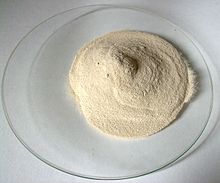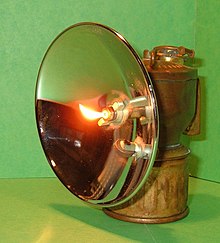Calcium carbide

| |

| |
| Names | |
|---|---|
| Preferred IUPAC name
Calcium acetylide | |
| Systematic IUPAC name
Calcium ethynediide | |
| Other names
Calcium percarbide
Calcium carbide Calcium dicarbide | |
| Identifiers | |
| |
3D model (JSmol)
|
|
| ChemSpider | |
| ECHA InfoCard | 100.000.772 |
| EC Number |
|
PubChem CID
|
|
| UNII | |
CompTox Dashboard (EPA)
|
|
| Properties | |
| CaC2 | |
| Molar mass | 64.099 g/mol |
| Appearance | White powder to grey/black crystals |
| Density | 2.22 g/cm3 |
| Melting point | 2,160 °C (3,920 °F; 2,430 K) |
| Boiling point | 2,300 °C (4,170 °F; 2,570 K) |
| Rapid hydrolysis | |
| Structure[1] | |
| Tetragonal (I phase) Monoclinic (II phase) Monoclinic (III phase) | |
| I4/mmm (I phase) C2/c (II phase) C2/m (III phase) | |
| 6 | |
| Thermochemistry | |
Std molar
entropy (S |
70 J·mol−1·K−1 |
Std enthalpy of
formation (ΔfH⦵298) |
−63 kJ·mol−1 |
| Hazards | |
| Main hazards | Reacts with water to release acetylene gas[2] |
| GHS pictograms |  
|
| GHS Signal word | Danger |
GHS hazard statements
|
H260 |
| NFPA 704 (fire diamond) | 
1
4
2 |
| 305 °C (581 °F; 578 K) (acetylene) | |
Except where otherwise noted, data are given for materials in their standard state (at 25 °C [77 °F], 100 kPa). | |
| Infobox references | |
Calcium carbide, also known as calcium acetylide, is a chemical compound with the chemical formula of CaC2. Its main use industrially is in the production of acetylene and calcium cyanamide.[3]
The pure material is colorless, however pieces of technical-grade calcium carbide are grey or brown and consist of about 80–85% of CaC2 (the rest is CaO (calcium oxide), Ca3P2 (calcium phosphide), CaS (calcium sulfide), Ca3N2 (calcium nitride), SiC (silicon carbide), etc.). In the presence of trace moisture, technical-grade calcium carbide emits an unpleasant odor reminiscent of garlic.[4]
Applications of calcium carbide include manufacture of acetylene gas, and for generation of acetylene in carbide lamps; manufacture of chemicals for fertilizer; and in steelmaking.
Production[]
Calcium carbide is produced industrially in an electric arc furnace from a mixture of lime and coke at approximately 2,200 °C (3,990 °F).[5] This is an endothermic reaction requiring 110 kilocalories (460 kJ) per mole[6] and high temperatures to drive off the carbon monoxide. This method has not changed since its invention in 1892:
- CaO + 3 C → CaC2 + CO
The high temperature required for this reaction is not practically achievable by traditional combustion, so the reaction is performed in an electric arc furnace with graphite electrodes. The carbide product produced generally contains around 80% calcium carbide by weight. The carbide is crushed to produce small lumps that can range from a few mm up to 50 mm. The impurities are concentrated in the finer fractions. The CaC2 content of the product is assayed by measuring the amount of acetylene produced on hydrolysis. As an example, the British and German standards for the content of the coarser fractions are 295 L/kg and 300 L/kg respectively (at 101 kPa pressure and 20 °C (68 °F) temperature). Impurities present in the carbide include phosphide, which produces phosphine when hydrolysed.[7]
This reaction was an important part of the industrial revolution in chemistry, and was made possible in the United States as a result of massive amounts of inexpensive hydroelectric power produced at Niagara Falls before the turn of the 20th century.[8]
The method for the production in an electric arc furnace was discovered in 1892 by T. L. Willson and independently by H. Moissan in the same year.[9][10][11] In Bosnia and Herzegovina town of Jajce Austrian industrialist, Dr. Josef Kranz and his "Bosnische-Elektrizitäts AG" company, whose successor later became "Elektro-Bosna", opened the largest chemical factory for production of calcium carbide at the time in Europe in 1899. Hydroelectric power station on the Pliva river with installed capacity of 8 MW was constructed to supply electricity for the factory. It was the very first power station of its kind in Southeast Europe, which became operational on 24. March 1899.[12]
Crystal structure[]
Pure calcium carbide is a colourless solid. The common crystalline form at room temperature is a distorted rock-salt structure with the C22− units lying parallel.[13] There are three different polymorphs which appear at room temperature, the tetragonal one, and two different monoclinc structures.[1]
Applications[]
Production of acetylene[]
The reaction of calcium carbide with water, producing acetylene and calcium hydroxide,[5] was discovered by Friedrich Wöhler in 1862.
This reaction was the basis of the industrial manufacture of acetylene, and is the major industrial use of calcium carbide.
Today acetylene is mainly manufactured by the partial combustion of methane or appears as a side product in the ethylene stream from cracking of hydrocarbons. Approximately 400,000 tonnes are produced this way annually (see Acetylene Preparation).
In China, acetylene derived from calcium carbide remains a raw material for the chemical industry, in particular for the production of polyvinyl chloride. Locally produced acetylene is more economical than using imported oil.[14] Production of calcium carbide in China has been increasing. In 2005 output was 8.94 million tons, with the capacity to produce 17 million tons.[15]
In the United States, Europe, and Japan, consumption of calcium carbide is generally declining.[16] Production levels in the US during the 1990s were 236,000 tons per year.[13]
Production of calcium cyanamide[]
Calcium carbide reacts with nitrogen at high temperature to form calcium cyanamide:[5]
- CaC2 + N2 → CaCN2 + C
Commonly known as nitrolime, calcium cyanamide is used as fertilizer. It is hydrolysed to cyanamide, H2NCN.[5]
Steelmaking[]
Calcium carbide is used:
- in the desulfurization of iron (pig iron, cast iron and steel)[7]
- as a fuel in steelmaking to extend the scrap ratio to liquid iron, depending on economics.
- as a powerful deoxidizer at ladle treatment facilities.
Carbide lamps[]

Calcium carbide is used in carbide lamps. Water dripping on carbide produces acetylene gas, which burns and produces light. While these lamps gave steadier and brighter light than candles, they were dangerous in coal mines, where flammable methane gas made them a serious hazard. The presence of flammable gases in coal mines led to miner safety lamps such as the Davy lamp, in which a wire gauze reduces the risk of methane ignition. Carbide lamps were still used extensively in slate, copper, and tin mines where methane is not a serious hazard. Most miners' lamps have now been replaced by electric lamps.
Carbide lamps are still used for mining in some less wealthy countries, for example in the silver mines near Potosí, Bolivia. Carbide lamps are also still used by some cavers exploring caves and other underground areas,[17] although they are increasingly being replaced in this use by LED lights.
Carbide lamps were also used extensively as headlights in early automobiles, motorcycles and bicycles, but have been replaced entirely by electric lamps.[18]
Other uses[]
Calcium carbide is sometimes used as source of acetylene gas, which is a ripening agent similar to ethylene.[19] However, this is illegal in some countries as, in the production of acetylene from calcium carbide, contamination often leads to trace production of phosphine and arsine.[20][21] These impurities can be removed by passing the acetylene gas through acidified copper sulfate solution, but, in developing countries, this precaution is often neglected.
Calcium carbide is used in toy cannons such as the Big-Bang Cannon, as well as in bamboo cannons. In the Netherlands calcium carbide is used around new-year to shoot with milk churns.[22]
Calcium carbide, together with calcium phosphide, is used in floating, self-igniting naval signal flares, such as those produced by the Holmes' Marine Life Protection Association.
Calcium carbide is used to determine the moisture content of soil. When soil and calcium carbide are mixed in a closed pressure cylinder, the water content in soil reacts with calcium carbide to release acetylene whose pressure can be measured to determine the moisture content.[23][24]
Calcium carbide is sold commercially as a mole repellent.[25] When it comes into contact with water, the produced gas drives away the moles.[26]
References[]
- ^ Jump up to: a b Konar, Sumit; Nylén, Johanna; Svensson, Gunnar; Bernin, Diana; Edén, Mattias; Ruschewitz, Uwe; Häussermann, Ulrich (2016). "The many phases of CaC2". Journal of Solid State Chemistry. Elsevier BV. 239: 204–213. doi:10.1016/j.jssc.2016.04.030. ISSN 0022-4596.
- ^ NFPA Hazard Rating Information for Common Chemicals. Northeastern University
- ^ Patnaik, Pradyot (2003). Handbook of Inorganic Chemical Compounds. McGraw-Hill. ISBN 0-07-049439-8.
- ^ Vincoli, Jeffrey Wayne (25 November 1996). Risk Management for Hazardous Chemicals. CRC Press. p. 429. ISBN 978-1-56670-200-3.
- ^ Jump up to: a b c d Greenwood, Norman N.; Earnshaw, Alan (1997). Chemistry of the Elements (2nd ed.). Butterworth-Heinemann. p. 298. ISBN 978-0-08-037941-8.
- ^ Calculated from data in the CRC Handbook of Chemistry and Physics.
- ^ Jump up to: a b Calcium Carbide, Bernhard Langhammer, Ullmann's Encyclopedia of Industrial Chemistry, Wiley Interscience. (Subscription required)
- ^ Freeman, Horace (1919). "Manufacture of Cyanamide". The Chemical News and the Journal of Physical Science. 117: 232.
- ^ Morehead, J. T. and de Chalmot, G. (1896). "The Manufacture of Calcium Carbide". Journal of the American Chemical Society. 18 (4): 311–331. doi:10.1021/ja02090a001.CS1 maint: multiple names: authors list (link)
- ^ Moissan, H. (1892). "Chimie Minérale – Description d'un nouveau four électrique". Comptes rendus hebdomadaires des séances de l'Académie des sciences. 115: 1031.
- ^ Renouf, Edward (1899). "The use of Acetylene". Popular Science Monthly: 335–347.
- ^ "Zgrada Prve hidrocentrale na Balkanu - Komisija za očuvanje nacionalnih spomenika". old.kons.gov.ba (in Serbo-Croatian). KONS. Retrieved 15 March 2019.
- ^ Jump up to: a b Greenwood, Norman N.; Earnshaw, Alan (1997). Chemistry of the Elements (2nd ed.). Butterworth-Heinemann. ISBN 978-0-08-037941-8.
- ^ Dun, Ya (2006-01-23). "Troubles in the PVC industry". Hong Kong Trade Development Council. Archived from the original on 2007-12-28.CS1 maint: bot: original URL status unknown (link)
- ^ "Government takes measures to curb development of calcium carbide sector". China Daily via BusyTrade.com. 2007-05-16. Archived from the original on 2007-02-11.CS1 maint: bot: original URL status unknown (link)
- ^ Lacson, Jamie; Schlag, Stefan; Toki, Goro (December 2004). "Calcium Carbide". SRI Consulting.
- ^ "Caving equipment and culture (from Te Ara Encyclopedia of New Zealand)".
- ^ Clemmer, Gregg (1987). American Miners' Carbide Lamps: A Collectors Guide to American Carbide Mine Lighting. Westernlore Publications.
- ^ Abeles, F. B. and Gahagan, H. E. III (1968). "Abscission: The Role of Ethylene, Ethylene Analogues, Carbon Dioxide, and Oxygen". Plant Physiol. 43 (8): 1255–1258. doi:10.1104/pp.43.8.1255. PMC 1087003. PMID 16656908.CS1 maint: multiple names: authors list (link)
- ^ "Bet on it. Your mango is ripened using carbide". dna. 2013-05-18. Retrieved 2018-08-25.
- ^ "Eating Artificially Ripened Fruits is Harmful".
- ^ "Carbidschieten wordt feest" (in Dutch). Algemeen Dagblad. 2016-12-24.
- ^ Singh, Randhir. "Determining Water Content In Soil – Calcium Carbide Method". Civil Engineering Portal. Retrieved 7 September 2020.
- ^ ASTM International. "ASTM D4944-18, Standard Test Method for Field Determination of Water (Moisture) Content of Soil by the Calcium Carbide Gas Pressure Tester". ASTM International. Retrieved 7 September 2020.
- ^ du Bois, T.M.E. "Molehill Mayhem". p. 21. hdl:1874/290102.
- ^ "How to Get Rid of Yard Moles With Carbide". mysunnylawn.com.
External links[]
- Calcium Carbide & Acetylene at The Periodic Table of Videos (University of Nottingham)
- Calcium Carbide Manufacturing
- 2008 Material Safety Data Sheet
- Acetylides
- Calcium compounds
- Deoxidizers
- Desiccants